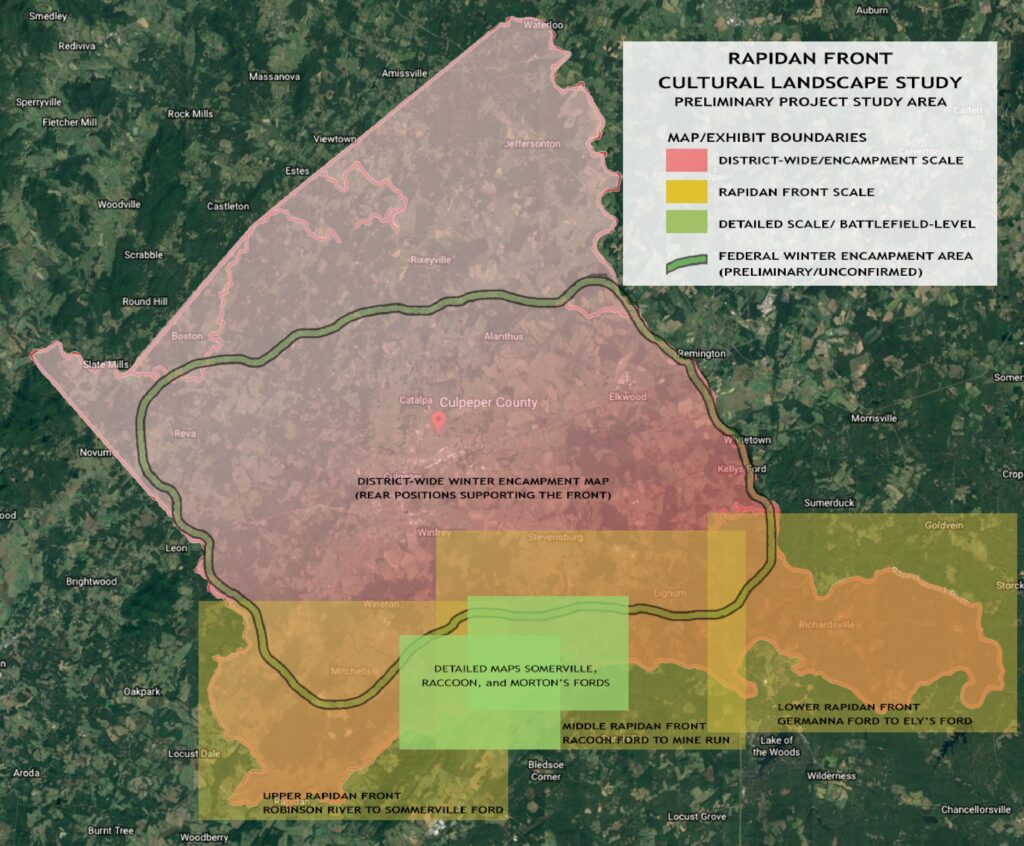We are very pleased and honored that John Salmon and Glenn Stach, well known for their expertise in historic research and preservation, will complete the research related to our Rapidan Front Landscape Study.
The Rapidan Front Landscape Study is supported by an American Battlefield Protection Program (ABPP) grant, term 2020-2022. Grant research will look at the 1863-64 Union Winter Encampment that brought more than 100,000 soldiers to Culpeper County and covered almost half of the county. Research will also look at Somerville, Raccoon and Morton’s Fords, critical Rapidan River crossing points for both the Union and Confederate armies during the Civil War. Please refer to the map at the end of this post for the preliminary project study area.
Meet the grant research team:
John S. Salmon, Project Historian for the Rapidan Front Landscape Study
project
John S. Salmon has been researching and writing about Virginia history for more than forty years. He holds a B.A. degree from the University of Virginia and an M.A. from the College of William and Mary, both in American history. He was an archivist (1972–1987) at the Virginia State Library (present-day Library of Virginia), where he compiled finding aids and guides to state records. In 1987, he joined the Virginia Landmarks Commission (now the Virginia Department of Historic Resources) as staff historian and state historical highway marker manager. He surveyed Virginia battlefields for the Shenandoah Civil War Battlefield Survey and the Civil War Sites Advisory Commission (1990–1993) and wrote The Official Virginia Civil War Battlefield Guide
(Stackpole Books, 2001) to 123 of the state’s battlefields including Cedar Mountain, Kelly’s Ford, and Brandy Station in Culpeper County.
After retiring from state employment in 2001, Mr. Salmon served as staff historian for the Tredegar National Civil War Center Foundation, helping draft plans for a national Civil War museum and learning center. Since leaving that position in the summer of 2004, he has served as a historical consultant. Mr. Salmon writes and edits marker and brochure texts for Virginia Civil War Trails, Inc., a nonprofit educational corporation. Since the mid-1990s, VCWT has created and installed more than 1,000 markers along driving trails linking Civil War sites in six states (Virginia, West Virginia, Maryland, North Carolina, Pennsylvania, and Tennessee).
Mr. Salmon has written more than seventy National Register of Historic Places (NRHP) nominations in four states. In Virginia, his Civil War battlefields and sites nominations include Beaverdam Depot (listed 1988), Fort Riverview (1989), Brandy Station (1989), Bristoe Station (1991), Belle Isle (1995), Fort Pocahontas (1999), Milford (2004), Unison (2011), and Rose Hill in Culpeper County (2020).
Mr. Salmon also wrote a Multiple Property Documentation form, “The Civil War in Virginia, 1861–1865: Historic and Archaeological Resources” (2000). In addition, he wrote a Preliminary Information Form (DHR) for “Rappahannock River 1862 Northern Virginia Campaign Rural Historic District, Fauquier County” (2011). He also wrote the historical narrative for “The Upper Rappahannock River Mapping Project: The Civil War in Culpeper and Fauquier Counties, 1862–1864” (2014) for Rivanna Archaeological Services. For the same firm, he wrote the historical narrative for the Ball’s Bluff Battlefield and National Cemetery Boundary Expansion, Loudoun County (2016).
Glenn Stach, Preservation Landscape Architect and Planner, Stach PLLC.
Mr. Stach is a subject expert practicing within the narrowly focused field of cultural landscape preservation and planning, with concentrated expertise in battlefield preservation. His ten-year involvement supporting battlefield preservation in Culpeper and Orange counties (with projects at Wilderness, and all six nationally recognized battlefields in Culpeper) afford him a healthy grasp of the cultural landscape and its many Civil War era features.
Mr. Stach recently completed a comprehensive analysis of Confederate Encampment sites across the Rapidan from the study area on Clarks Mountain and in the process collected compelling contributing source material investigation for this study area. Additionally, Mr. Stach led a viewshed study encompassing much of this study area that demonstrates the interconnectedness of the wartime wig-wag signal station network across this region and historic and contemporary relevance to viewshed integrity and preservation. In 2014 Mr. Stach was hired by VDHR to lead battlefield friends development efforts across the commonwealth, a project funded by the ABPP that has had a profound effect on the organizing and support for battlefield resources in Culpeper. Mr. Stach will support John Salmon in mapping the resources of the grant study area, bringing his analysis and cultural landscape perspective (KOCOA) to the study.


